FASTER eBIKE
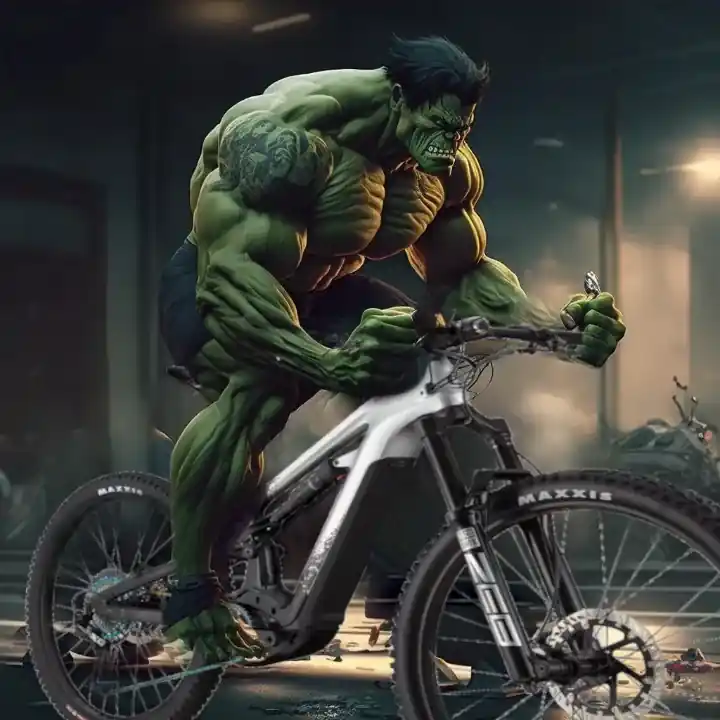
How To Make An eBike Faster
There are many quick, easy, and cheap ways to increase the power of an electric bike.
eBike power can be boosted by simply turning a ‘pot’ screw on the controller, disconnecting the power smoother connector, or simply fitting a higher voltage battery.
Alternatively, high spec eBikes (where battery and controller can be hard to access) can be fitted with performance chips.
It is often far easier to boost the speed of an electric bicycle motor than it is to improve the power of gas powered engine.
I step through tuning options one by one starting with the simplest and cheapest ways to increase the power of your electric bike.
How can I increase the power of my electric bike?
1. Remove power smoothing
Poor travel distance is a major limiting factor to the sale of electric bicycles. Many eBike manufacturers include power smoothing circuits in their controllers. Power smoothing extends the range of the battery by limiting power supply from the battery when the motor is under load.
eBike motors draw more power when pulling away from a standing start. The power smoothing circuit reduces the current that is supplied to the engine during acceleration.
Although power smoothing extends distance that the ebike can travel, it severely reduces the power available to the rider. Personally, I find these circuits very frustrating as I prefer to have the electric motor to provide most power when I first start riding.
The good news is that this circuit can be quickly identified and easily disabled. All that is required is to disconnect a plug.
First, unscrew the controller housing to access your controller unit. Remove the controller unit from the housing so that you can inspect all the wires. Look for a single wire from the controller that loops back into the unit. Most controllers have this wire looped back through a connector which can be easily unplugged. If you have a wire that loops back into the controller, this will be the power smoothing circuit.
To boost power, simply unplug the connectors. If extended travel is more important to you, make sure the plugs are connected.

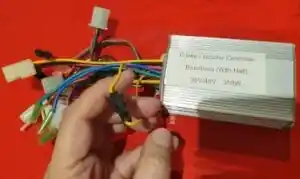
Uncouple the power smoothing connector
When the wire is disconnected, replace the controller in its housing and take the bike for a ride. You will notice a marked improvement in acceleration. Travel distance will, of course, be reduced by a few miles.
More power means more heat
I would like to point out that if you increase the power supplied by the controller, you increase the heat of the unit. Although adjusting the pot or removing power smoothing will not exceed electrical tolerance of the components, heat dissipation is a major factor in reliability.
Experience has shown that the controller is the Achilles heal of ebikes. You should, therefore, seek additional methods to cool the controller and motor.
Ensure good air flow around the systems and, if possible, attach additional heat sinks.
2. Increasing power to an electric motor is as simple as turning a screw
Power to the electric motor is supplied by the controller. Most ebike controllers have a variable potentiometer, or ‘pot’ that is used to adjust the power supplied by the controller.
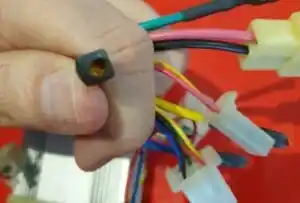
External ‘power POT’
Some controllers have an easily accessible pot outside the controller casing. Check your controller for a wire extending on the outside of the controller unit that terminates with a screw head rather than a connector. This will be the pot.
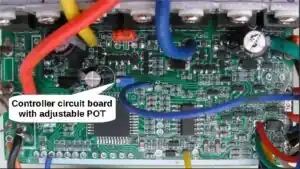
Internal ‘power POT’
In most units, there the pot is not visible outside the controller but is available on the circuit board inside. If you have no external pot, you will have to open the controller casing to look for the component with a small adjuster screw. The pot can be identified easily as it will be the only electronic part with a screw head.
Simply turn up the power
The direction of turn the pot screw for increased power varies with each model of controller. You may have to turn the pot screw either clockwise or anti-clockwise to increase power. The power increase requires a little bit of trial and error. Turn the screw ¼ turn clockwise, reassemble the controller and take your ebike for a ride. Hopefully, more power will be available. If not, try turning the pot back ½ a turn and try again.
3. Can I use 48v battery with 36v motor
Increasing battery voltage is the most effective way of increasing the power of your ebike. Increasing the battery voltage increases the power exponentially. You can increase the power of your ebike by adding a small additional “booster” battery or swap out your battery pack for a higher voltage battery. Before you upgrade your battery, there are a few things you should be aware of:

A higher voltage battery increases power
The first misconception is that a bigger battery will increase power. To be clear, battery power is rated in Ampere Hours (AH) for a specific Voltage. For 250 Watt ebikes, a 36 Volt 8AH battery is typically supplied on low cost bikes and a 36 Volt, 12AH battery is provided on more expensive models. Higher battery ratings are available but not common due to their weight and cost.
When you swap for a higher voltage battery, it can supply more power to the motor and provide significant increase in speed and acceleration. A more powerful battery (larger AH rating of the same voltage) will extend the range of ebike travel but will supply an insignificant amount of additional power to the motor.
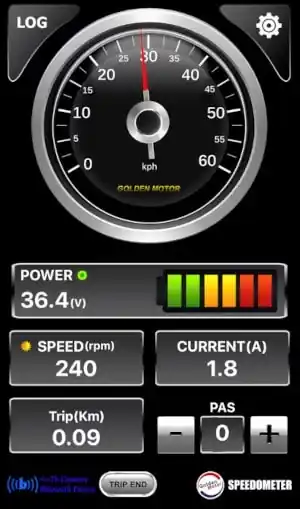
Electric bike power calculator
For a given load, the resistance of an electric motor does not vary wildly. Simplifying the technicalities of an electric motor, we can view it as a large resistor. Ohms law, from high school physics, tells us that Power = Voltage2/Resistance. This means that when we double the voltage, we quadruple the power.
In reality, engine resistivity does increase slightly as more load is applied (more acceleration or speed = greater load) and a fully charged battery is around 25% higher than the rated voltage.
In real world applications, a 36 Volt 250 watt controller will supply around 350 Watts when a 48 volt battery is connected.
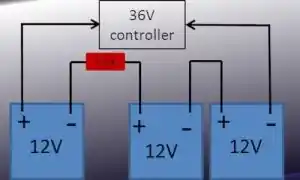
Electric bike battery replacement
How to connect a booster battery
If you have a Sealed Lead Acid (SLA) battery pack, it is straight forward to add a power booster battery. 12 Volt SLA batteries are readily available and additional 12Volt units should be connected in series to increase the voltage.
Refer to the diagram as a visual guide of how to connect the batteries.
Li-ION battery replacement
Although the same concept applies to Li-ION batteries, adding power booster batteries to Li-ION is not recommended. The problem with Li-ION battery packs is that they are made by connecting a multitude of smaller power cells. Li-ION batteries can be damaged easily or alternatively, present a fire hazard. Li-ION batteries are, therefore, fitted with protective management systems that ensure that the batteries are not over charged and are protected from being drained of charge. Managing Li-ION battery charging reduces fire hazard while limiting battery drain extends battery life.
Adding a booster pack to Li-ION would complicate the system, compromise the management circuitry, and risk the integrity of the original battery pack. With Li-ION batteries you should replace the entire battery pack or, change the power management system if you are adding additional battery cells.
Verify that the controller can cope
There are a few items that you should check before you connect a higher voltage battery to your bicycle motor.
1. First, you should be aware that using a higher voltage battery will negate any warranty that you may have with the electric motor kit or eBike.
2. It is essential that you verify the power rating of the controller on your eBike. Most controllers are rated for one step up in voltage. For example, 36 Volt controllers are usually rated to run on 48 volts and 48 volt systems to run on 56 volt batteries, however, this is not always the case.
If your controller is not rated to accept a higher voltage battery, then you risk burning out the controller very quickly.
Check the Controller Rating
Controller voltage and power ratings are usually marked in an obvious location. Typically, specs are listed on the side or the back of the casing. If manufacturers fail to provide any specs on the casing, look for the model number of the controller. A Google search on the model number should provide the required information.
Increasing eBike Power
Most controllers automatically adjust to one step up in battery voltage. For example, a 36 Volt, 250 Watt eBike will automatically become a 350 Watt system when a 48 volt battery is attached.
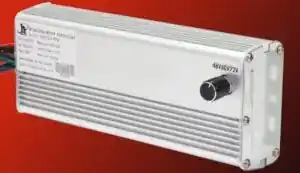
Multi voltage controllers
If the controller is rated for multiple battery voltages (e.g. 36, 48, 56 and 72 Volts), these systems often have manual switch on the outside of the controller casing in order to manually set the battery voltage.
As controllers are the most fragile component of electric bikes, it is essential that the battery voltage remains within the rated limits of the system. Also, if you increase the power output the bicycle engine, it will increase the heat in the motor winding’s and the supply wires. The additional heat places more strain on the electric motor.
The wireless system requires no cable porting to hide ugly connector wires. RockShox design is fantastic, neatly integrating the compact, rechargeable batteries into the fork and shock modules. There is no bulky central power source or controller. This makes fitting neat, straightforward, and convenient.
The shock module adds a little bulk to the shock size, with the battery sitting at the back to protect the unit from crash damage. Although the system is compact, some frames may not have clearance for a Flight Attendant-equipped shock. Flight Attendant is offered on RockShox ZEB, Lyrik, and Pike forks.
As stated above, Flight Attendant is currently provided only on bike packages from a few manufacturers. We expect DIY suspension upgrades will be available for individual purchase by mid 2022.
Can bicycle motors accept more power?
Electric motors themselves cope with the additional power well. We have never had any major issue with stepping up from 36 to 48 volt systems. Wherever possible, we improve air circulation and fit additional heat sinks to help the reliability of the ebike motor.
We have rarely encountered any issues with putting extra power through the electric motor itself. We have, however, seen many cases where a voltage upgrade has produced sufficient heat to melt the power wires supplying the engine.
To assist with heat dissipation, we always try to increase air flow around the controller, power wires and motor. If heat sinks can be added to electric components, this also helps to increase the reliability of the bicycle motor. In the occasions that we have discovered wires with melted insulation, we strip the controller back and solder higher rated wire to the power lines.
Check electrical connectors regularly. It is important to ensure that the connectors between the electric motor and the controller are kept clean, free from corrosion, and have good contact area. Similarly, check the power cables leading from the battery to the controller. Poor contacts increase resistance which reduces power supply. More important than the small loss of power is the additional heat produced in the connectors.
Long trips
We would also suggest that you be mindful when taking long trips. If you are planning a long journey, back off the throttle a little or stop for short periods to allow the electrics to cool down.

Higher rated controller for bicycle motor kits
If the controller on your ebike conversion kit is not rated for higher voltage then it is possible to purchase a more powerful unit. Controllers can be purchased on Amazon for around $70 and can be simply fitted in 2 minutes using the same connectors.
There is a huge selection of up-rated to choose from. Finding a replacement controller for a bicycle motor kit is relatively straight forward as most of the fundamental connectors are standardized. The throttle interface is usually the only non standard part.
Depending on the throttle design, these connectors can be as simple as 3 wire plugs but we have seen throttle’s as complex at 6 wire plug plus a 2 wire side coupling. Be careful to select the correct throttle connector when you are purchasing a replacement controller.
Higher rated eBike controllers
It can be complicated to swap for a higher rated controller on an ebike. Purpose built ebikes have a number of additional wires to service proprietary features. Ebikes often have ignition switches, lights, speedometers, battery level indicators and LED displays.
These additional features have no standard couplings. Unless you want to discard all, or most, of the additional features on your electric bike, you are locked into the manufacturer. Check with your ebike manufacturer to ask if they can supply a higher rated controller that is compatible with your model of ebike.
